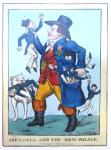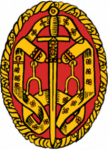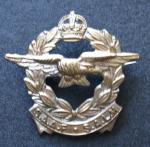-
Posts
13,225 -
Joined
-
Last visited
-
Days Won
22
Content Type
Profiles
Forums
Blogs
Gallery
Events
Store
Everything posted by Mervyn Mitton
-
Jef - I am most surprised that you have found reference to this badge for a Belgian Military Court. I would have expected it to be Italian of pre WW2 vintage. The badge represents - of course - the early Roman Republic Fasces - carried in front of Magistrates and the two Consuls. The bound rods - on their own - represented that the official had the authority to order corporal punishment. With the axe bound in the centre, then he also had the power to order execution. They were carried in front of the official by Lictors - and the greater the rank the number increased. I think the Consuls had 24 Lictors. Mussolini tried to base his Fascisti Regime on the Roman Republic to give it authenticity - hence all of these symbols. Out of interest could you show a picture of the Belgian one - also , did they use it anywhere else ? Mervyn
-
jaeger7 - this may be a tough one - unless he went on to hold high rank and therefore will have his picture more readily recognised. Do you have any further details that might help to 'pin' him down. He is wearing the metal shoulder straps that indicate probably an armoured Brigade ? You may find that the German press of the period could have carried his picture ? Anyway, we must hope one of our members will recognise him ? Mervyn
-
Great shame - but you have to respect her wishes.
-

sabretache
Mervyn Mitton replied to blueman's topic in Great Britain: Militaria: Badges, Uniforms & Equipment
Apart from a little wear to the patent leather the back is in good condition. Are there any initials or, scraps of paper inside that would help with an identification of the officer ? Did you buy it locally - was there any hint of the family ? Mervyn -

Cossack Swords and current market prices...
Mervyn Mitton replied to vladtheman03's topic in Swords & Edged Weapons
Vlad - whilst I agree with Kevin that this would have been better on the Members Identification section - this is not going to be an easy question to answer. I would advise that you send a copy of the photographs and your enquiry to the following two militaria auctions in London. Thay should be able to assist. Wallis and Wallis Lewes Sussex. UK Christies Militaria Dept. St. James Square London. UK. Best wishes. Please let us know how you get on ? Mervyn -

sabretache
Mervyn Mitton replied to blueman's topic in Great Britain: Militaria: Badges, Uniforms & Equipment
Blueman - a lovely example of an officer's sabretache and for a famous regiment - the 16th Lancers. Originally Light Dragoons their earlier Battle Honours are around the top part. In 1816 they were reorganised as a Lancer Regiment and became the 16th. They spent many years in India - mainly as a result of upsetting King George 4th. His wife was Queen Caroline - who he hated - and the 16th were the 'Queen's Own' and toasted her at every opportunity. All of the Battle Honours are from their time in India - and the Afghanistan campaign was in 1839 and in support of the Hon. East India Company. The lower Honours are the Sikh campaigns. This dates the sabretache to an early period - certainly pre 1885 when they fought the Suakin campaign in Sudan. Sabretaches were worn as decoration over the sword - but, their real purpose was as a map and document case. The back opened to make a waterproof compartment. I congratulate you on this lovely and rare item - for the leather a special leather preservative should be used to keep it supple. Value wise - hard to say - you should contact one of the London auction houses. I would not be surprised - with this early date if it could achieve 2000 pounds - or, more. Please show a picture of the reverse to complete the picture. -
This is neither a print or, of great age. The little Dachsund was mine when I lived in Thailand in 1960 so, 52 years old. The reason I am showing it is that it uses a technique which has become rare in today's World. Known as scraperboard the card is specially printed black. The artist uses a scalpel to 'scrape ' away the detail leaving the subject in white outline. One mistake and you start again - probably why it is not used a lot now. I have always found it to be a very attractive medium.
-
The breed standard for Dachshunds in 1882. This is a good example of how old prints are still useful. A firm called Cassell's used to send artists to all of the Agricultural Shows and draw the winning animals. These were then printed and copies sold to the owners' of the animals. This was sufficient for them to make money.
-
I think old prints can give a lot of research material and are invaluable for seeing how people lived their lives in these earlier times. Please feel free to add to this post - there is no limitation on subject or, period. This first picture dates from 1829 and shows 'John Bull' dealing with the new police who had just been introduced. The papers and magazines had been very hostile to the idea of a regular Police Force and when the Metropolitan Police came into being in 1829 they were not well received. The French Revolution had only been some 36 years earlier and it was thought the Police could become an oppressive arm of the Government. Shows the uniforms well and note the decorated truncheons in the waistcoat pocket.
-
One reads a lot of the famous British 'Square' and how effective it was against Napoleon's cavalry - this detailed and valuable print from the ILN of 1879, shows the British Square in action in the final battle of the Zulu War. The Battle of Ulundi. The perspective is about the middle of the Square and General Chelmsford and his staff are shown on horseback. He later went onto become the Viceroy of India. Lt. Gen. Chelmsford had 5000 British troops available - although the Zulu Impis greatly outnumbered his Force. We had our Infantry Regiments - we had the famous 17th Lancers - although only some 240 of them. And in the far right of the Square you can see a lot of smoke - this was the first Maxim Battery in the British Army in action. You can see the lances in front of the smoke and beyond them the black dots represent the Zulu Impis. The Battle was not an easy victory for us - Thhe Zulus fought strongly and bravely and at one point nearly broke through our 'wall of men'. However, we had un-engaged units and a bayonet charge helped to repel them. When Lord Chelmsford judged it was the right moment the right side of the squars folde back in two parts and the 17th Lancers charged. The 9 foot lance (nearly 3 metres) is a terrible weapon and it forced the Zulus to retreat. The King retreated with his Bodyguard and that , effectively, was the end of the Anglo-Zulu War. It had taken only just over 6 months. I find that of all the Wars fought in South Africa this is the one that has the imagination of the public - and with it's short time span - they can follow-it. In 1999 we had all sorts of ceremonies for the Boer War - apart from one or two re-enactments the public could just not follow the sequence of events and the many different battles and scrimmages. I think that something similar will happen with the WW1 ceremonies.
-
It is possible that I may have posted this print previously on another one of our Forums - I don't think it matters as it ties in well with the tactics section of this Forum. Fort Pearson - named after the Colonel in charge is along the North Coast and borders the Tugela River - the boundary for Zululand. The river was quite wide and deep in those days and at the mouth of the Estuary we had H.M.S. Tenedos as the guard ship. For the invasion of Zululand we had to build a fort on the opposite bank - Fort Tenedos - and build a barge that was pulled across by donkeys or, oxen. The teak for the barge came from H.M.S. Tenedos and it was crewed by her seamen. However, nearly all of the Services were involved. Approx. half a Company - 40-50 soldiers could be carried at one time. Sailors were on board and Naval Officers directed operations. However Signals Officers were also present The Semaphore signalman from Tenedos is clearly shown and at one time I had his Zulu War Medal - out of 5 signalmen on board he was the only one to go ashore and so received the 1879 Bar for his Medal. Also shown are Zulu Guides and even a workman to help push the barge off. A very well detailed drawing which appeared originally in the Illustrated London News in 1879. This is an original.
-
Lew - sorry, I missed your last Iklwa. Broader head then they usually have - the two best ways to ensure they are Zulu are 1. look immediately below the blade - there should be two small indentations where the smith's tongs held the blade for beating into shape. 2. Zulus beat out from the centre towards either edge. This leaves a raised section along the middle. Going through some old prints for posting on our Documents section, I found a number with early Zulu ref. from the 1879 war. I will post some now - and the others at a later time. Mervyn
-
Hello Monty - delighted to hear from you and best wishes for 2012. What are the projects you are working on at present ? I never heard back from the City Curator - I expect she had other Insurance valuations. Your identification of the Gold Pass is excellent - we had a long discussion on it - but, never reached a conclusion. Now that you have it pinned as the personal pass for the Commissioner I'm very pleased that I haven't given it away. Thankyou for recognising the initials. Mervyn Dave - I am grateful for you up-dating my post. I was not aware that the Magistrate status had been withdrawn from the Comm. and the Dep. Comm. I suppose in this day and age - and with the dropping of the Riot Act - that it was un-necessary. Still old Honours and Traditions are being discarded too quickly - a Force without pride in it's past becomes like a security company. Your info. on the tokens and new warrant cards is also very informative - we need this up-to-date info. I don't see the Job papers here and my interests are more historical. Mervyn
-

New Year Honours List 2012
Mervyn Mitton replied to JPL's topic in Great Britain: Orders, Gallantry, Campaign Medals
Hi Jean-Paul. All of these knighthoods on the front page are for Knights Bachelor (KB). This is the oldest order of chivilary in Britain - over 800 years. However, it ranks below all of the Orders (Knight of the Garter etc.) Until 1926 they had no official badge but, after petitioning King George 5th. they were granted their own insignia. This features the items necessary for a Knight - sword, belt, spurs. -

Victoria Cross replica
Mervyn Mitton replied to kjf101's topic in Great Britain: Orders, Gallantry, Campaign Medals
Yes, I agree with you. With this provenance and a known history this has to be about the closest you could get to an original. I see a similar daily wear copy sold for over $4000 - it will be interesting to see what this one fetches ? -
Blueman - now I am a little worried for you - this is a French Gras bayonet. Are there any markings that could indicate a number ?











